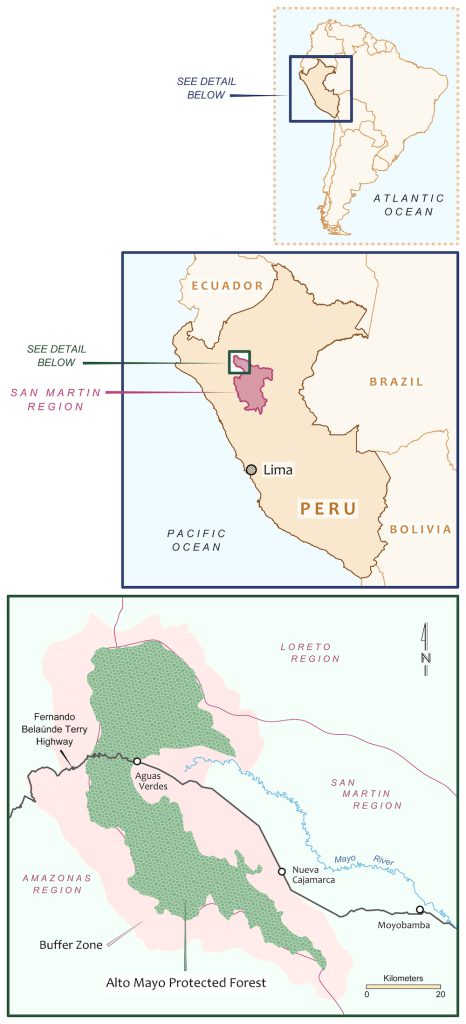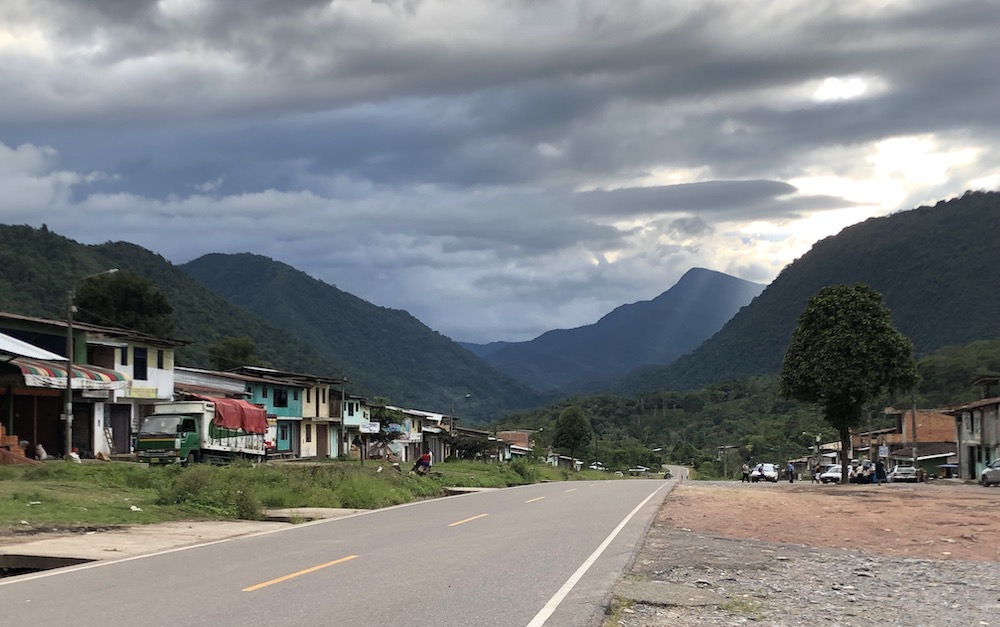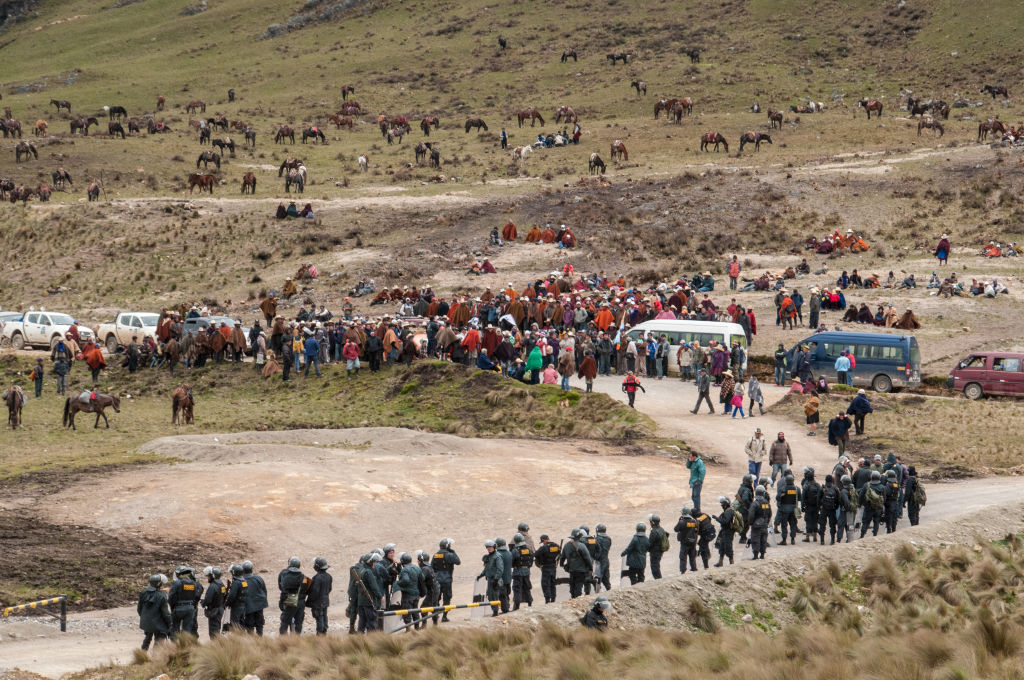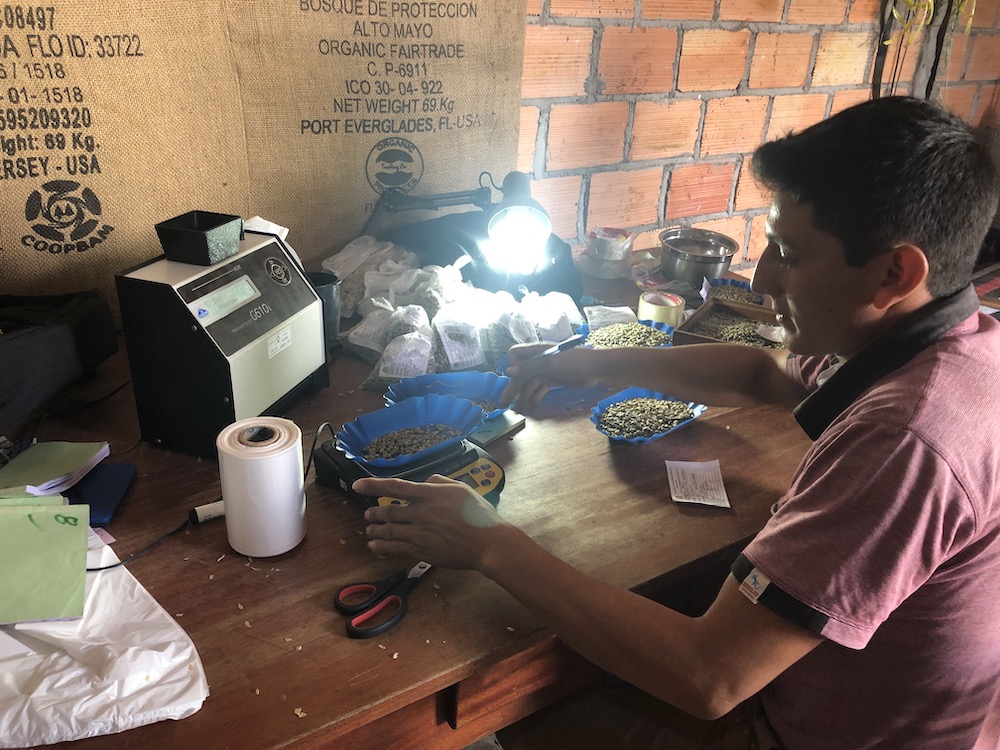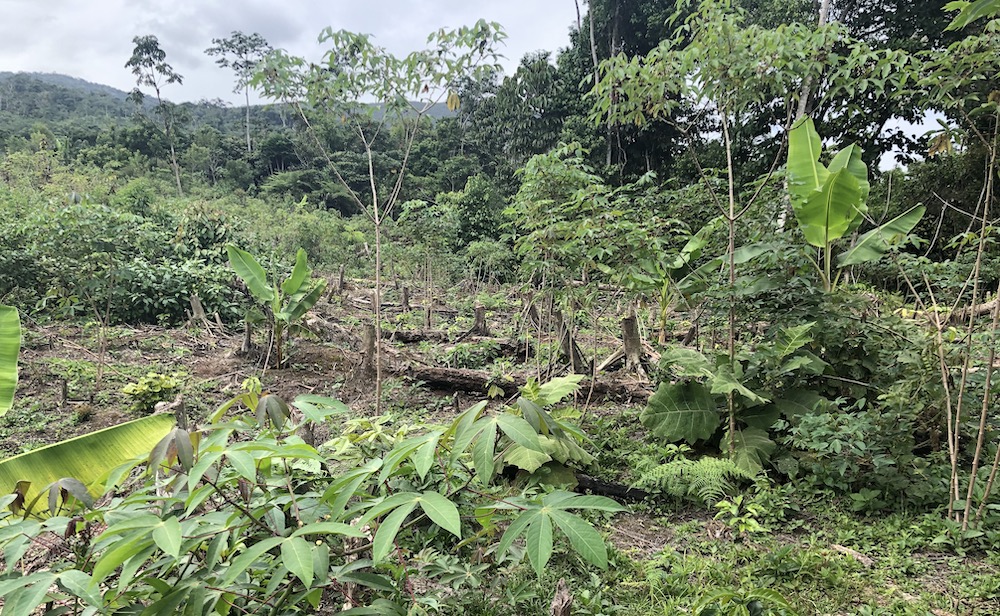When Carbon Credits Drive People From Their Homes
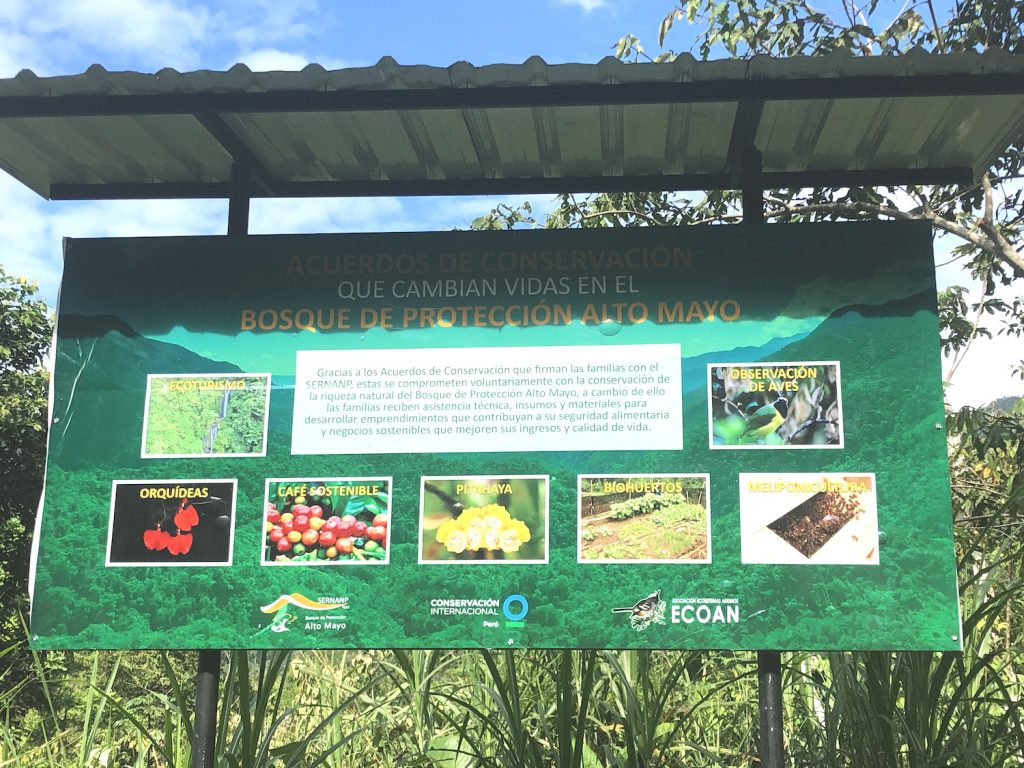
The Mayo River begins in the tropical cloud forests of Northeastern Peru. Where the Andean foothills meet the Amazonian plains, bromeliads, ferns, and mosses grow under palms, tropical hardwoods, and the liana vines that climb their trunks. The giant armadillo, spectacled bear, and yellow-tailed woolly monkey live in these forests. Farmers grow coffee on the slopes and rice and cacao in the valley.
Jose Gilmer Vasquez moved to the Mayo River basin in the 1990s. Just before he arrived, in 1987, the Peruvian National Park Service (SERNANP) drew a boundary around the upper part of the valley to protect its water quality and rare biodiversity, creating the 182,000-hectare Alto Mayo Protected Forest. Gilmer Vasquez had no idea the park even existed, let alone that he had just informally bought farmland inside it.
“There wasn’t a sign or anything,” he says.
The area’s protected status became more evident to Gilmer Vasquez and hundreds of families like his around 2008, when U.S.-based Conservation International (CI) started working in the area. CI hired park guards, purchased jeeps and drones, and installed a central office and ranger stations at points throughout the forest. In partnership with SERNANP and local nongovernmental organizations, they started asking farmers to sign agreements to refrain from cutting down trees and expanding their farms.
In exchange, farmers would receive technical support to grow coffee under the cover of the forest, producing shade-grown beans that CI would help them sell to specialty markets abroad. CI registered the project as part of REDD+ (Reducing Emissions from Deforestation and forest Degradation), a climate change mitigation strategy developed under the United Nations Framework Convention on Climate Change.
In REDD+ projects, the CO2 kept out of the atmosphere by planting or protecting trees is eligible for “carbon credits” that can be sold on the open market to companies or countries. The buyers, usually high emitters in wealthy nations, use the credits to compensate for their fossil fuel burning elsewhere in order to meet emissions reduction targets. Eventually, CI sold millions of dollars’ worth of carbon credits from the Alto Mayo to the Walt Disney Company to offset the emissions from its cruise liners.
The CI website describes the initiative as “one of the world’s few REDD+ projects to see continued success”—a case study for how conservation can go hand in hand with economic growth. The organization extols the project for keeping trees standing while providing hundreds of smallholder farmers with the technical support to still make money.
But when I spent the summer there as an environmental anthropology student in 2019, the situation on the ground looked very different from how it did on paper. While some farmers were happy with the projects, some 600 families, or half the farmers in the park, refused to sign on to the conservation agreements. A large, vocal group of them was locked in an escalating, violent conflict with the park administration. Gilmer Vasquez is one of the young leaders of this movement.
I talked to dozens of farmers, project participants and nonparticipants, park staff, and Indigenous Awajún people living around the edges of the protected area. The picture of forest conservation that they painted was far more complex than a black-and-white battle between forest threats and forest guardians.
Everyone agreed that deforestation is an issue, but the extent of the problem and what the solution should be were entirely up for debate. Many described the farmers who didn’t want to sign on as illogical, miseducated about the benefits of the forest, or covering up criminal activity.
But others saw those farmers as conservationists in their own right who deserved land rights and more. They told me that the conservation effort is acting to deny people living in the valley essential services in an attempt to push them out of the forest, and they noted the hypocrisy of a government trying to save the environment with one hand while destroying it with the other.
Some worried the conservation projects were a scheme to make way for a secret deal with a mining company. “There’s no other explanation!” said one farmer I interviewed.
Given the larger context of carbon markets, land insecurity, and a local tradition of self-governance, farmers’ opposition to the project makes more sense.
With the central place of carbon trading and forests in the international climate change negotiations (COP26) in Glasgow this past November, alongside ongoing concerns voiced by local and Indigenous peoples about the carbon market leading to dispossession, it’s a critical moment to look closely at forest conservation in Peru.
Gilmer Vasquez flips through a binder in a noisy café alongside the highway that runs across the Alto Mayo basin, cutting through the park. We had arranged the meeting through a chain of friends and relations, since his home in the protected forest has no cell service, internet, or electricity.
He has brought along legal documents from his 2016 arrest for being part of a group that detained and flogged park guards for violating a local injunction to stay out of town. Next are papers related to his arrest a week prior for leading a blockade along the highway, where farmers from 12 villages inside the park stopped traffic to and from the coast, demanding schools, health posts, and the removal of a police base. The blockade lasted four days; harvests spoiled in the trucks. Eventually, it was broken up by a small army of police officers shooting tear gas.
“They gave us state services like teachers and health posts, and then they take them away,” says Gilmer Vasquez. “They build the roads, and then they get mad when people come here. Where are we supposed to go?”
Starting in the 1960s, Peru’s then-President Fernando Belaúnde Terry began enacting his neoliberal vision of opening the Amazon to extraction and agribusiness, connecting the cities in the jungle to the cities along the coast with a network of roads. Beyond incorporating the Amazon into the national economy, encouraging Andean migration to the jungle served two additional purposes: It quelled demand for land reform in the mountains and diverted migration away from Lima, where social unrest among the poor was growing.
Between 1972 and 1981 the population of the Mayo River basin doubled. Migration to the region continued over the years, encouraged by farming subsidies, road construction, and export infrastructure for boom crops including rice, corn, coffee, and oil palm.
The construction of the highway has had devastating effects on the local Indigenous Awajún communities, whose titled territories sit just outside the boundaries of the Alto Mayo Protected Forest. Migrants establish themselves on Awajún lands, sometimes clashing violently with the communities, while local governments do little to intervene. More recent arrivals to the region have also settled higher on the mountain slopes, in places like the Alto Mayo Protected Forest. In the 1980s, there were three towns inside the park. By the time CI entered the picture in the 2000s, there were 26.
Nearly half of the migrant farmers in the area, including Gilmer Vasquez, hail from Cajamarca, a region of the Andean mountains where high-profile mining projects cause ongoing dispossession and environmental destruction. The government’s insistence on protecting the forest they now live in through the deal with CI strikes many of them as ironic and hypocritical. They call it the “double discourse” of the state. In one spot, plans are in place to protect water, while in another, deals are signed for industries that divert and poison it.
Cajamarca is also a hotbed of peasant resistance. In the 1970s, it was the birthplace of the ronda campesina (peasant self-defense rounds), a local tradition of community protection that emerged in the Andean highlands as a response to cattle theft at a time when police departments and courts were distant, expensive, and corrupt. Villagers organized themselves into nightly patrol groups that evolved into people’s courts. “It is the most effective justice,” says Gilmer Vasquez. “It’s fast, and it’s cheap. We call it the justice of the poor.”
Ronda groups, whose members are called ronderos, have become well-known throughout Peru for defending local and Indigenous land rights against corporate environmental destruction. In Cajamarca, the rondas campesinas famously went up against the Conga mine, a proposed expansion of a U.S.-owned gold and copper mine that had already devastated ecosystems, water sources, locals’ health, and livelihoods. Collaborating with other agrarian and Indigenous groups, the ronderos fought a high-profile case that ended up before a commission on human rights in 2012; they successfully held off the US$4.8 billion project.
Andean farmers brought the rondas campesinas, their tradition of land rights militancy, and their justifiable distrust of the government to the jungle. “It’s not easy to make a rondero bow his head,” says Santos Saavedra Vasquez, one of the lead litigants in the Conga fight, who is now the president of the National Union of the Rondas Campesinas of Peru. After years of farming and organizing communities with relative autonomy in the Alto Mayo, when park staff started approaching in 2011, the farmers hurled rocks.
Like all the ronderos I spoke to, Flavio Flores, the ronda representative for the San Martín region, where the Alto Mayo Protected Forest is located, tells me that conservation has always been part of the ronda code. According to Flores, the resistance against the state, CI, and other NGOs isn’t about being asked to farm sustainably, which farmers were already doing.
In the café, Gilmer Vasquez draws a picture of a rotational agriculture system on a napkin, showing how crops are planted in one area while another section is left to regrow into forest in a shifting pattern. His town has a communal protected forest and bans hunting in certain areas. They were already taking care of the forest, he says. Why do they need to do things CI’s way?
For many, signing a predefined agreement seemed akin to signing away their rights to the land and to self-governance.
The highway blockade Gilmer Vasquez helped organize took place in Aguas Verdes, a town at the edge of the protected forest where the road crosses into the park. The day after the protest ends, I am able to go visit. Driving north, I pass rice fields, banana plantations, roadside restaurants, nightclubs, churches, small clusters of wooden houses, and larger towns. It’s the dry season, and the air is cool and the road dusty.
In Aguas Verdes, tension hangs in the air. The town remains split between conservation agreement subscribers and nonsubscribers, and they are at war with each other. Neighbors don’t speak; women peer out of doorways down the empty streets and dart quickly across the dirt roads to run their errands.
I meet a woman, Vanessa Cuipal Álvarez, whose parents were among the first Aguas Verdes residents to sign SERNANP agreements in 2011. Cuipal tells me that during the strike, she had to sneak home along back roads to avoid neighbors calling her a traitor and blocking her path. Her family moved to the area 35 years ago from the neighboring region of Amazonas due to drought and lack of arable land. While initially skeptical of the agreements, Cuipal and her parents are now a poster family for the Alto Mayo Conservation Initiative, appearing in promotional materials across funder websites.
Cuipal’s family members are involved in everything a sustainable development nonprofit could possibly offer—from artisanal craft collectives to clean cookstoves. Her father grows experimental coffee varieties beneath cedar, guava, and linden trees, and sells his organic coffee at a CI-bankrolled cooperative. Her mother keeps bees, raises guinea pigs, and sells pitahaya, a native fruit promoted by local NGOs. “Every little bit of income helps,” says her mother. Behind their house, Cuipal has established a nursery for orchids that grow on abandoned coffee farms and has applied for a permit to sell them to tourists.
“If you provide [services], people will want to settle down. We’re not going to urbanize the protected forest,” says Conservation International’s Fernando Guerra.
Cuipal’s older sister, Sara, is a park guard. She has a week off from patrolling the forest and is home visiting her own daughter. Guards hired from the local communities in and around the park are stationed far from home so as to protect their families from retribution.
I ask Sara why she thinks so many people in the forest refuse to acknowledge the authority of SERNANP and refuse to sign conservation agreements when they have worked out so well for her family. She chalks it up to ignorance, to pressure from the rondas campesinas, and to conspiracy theories about mining.
There are also those who say they need more farming support, or want financial support, she says, in exchange for their conservation work. In fact, 39 percent of subscribers withdrew from the program in 2016, citing insufficient benefits.
Of course, Sara adds, “there are also some ronda leaders who are invested in illegal activity.”
Sara’s boss, Ivonne Paico, reiterates this. As SERNANP’s head of the protected area, Paico categorizes the farmers as “good” ones who respect the authority of the agency and “bad” ones who do not. The bad ronderos, according to Paico, organize against the conservation agreements and are probably engaged in logging deals, clearing land in order to sell it, or other illicit activities. As such, Paico says, they have to be removed.
SERNANP has been coordinating flyovers of the area. They see ongoing deforestation in the northern part of the park, and sometimes apprehend truckloads of illegally harvested trees on the way out.
At the coffee cooperative in Aguas Verdes, I meet Felipe Solano (name changed to protect his privacy), a 30-year-old farmer who arrives on foot, having walked for three and a half hours through the forest carrying sacks of coffee. He speaks gently, sitting upright on a wooden pallet on the floor in the back of the cooperative. He is happy with the programs he is involved in but points to some ongoing issues, like the lack of water sanitation services in his town of Nuevo Eden. He says the town used to have a health post, but it was removed by park administration. Several villages throughout the park have also had preschool and primary school teachers evicted. Most of all, Solano wishes for a road to his community so people could access Aguas Verdes more easily. He has petitioned the park administration about this but to no avail.
This is something I hear repeatedly from people living in the park: the need for basic services coupled with the hope that by exhibiting good conservation behavior, these needs might be granted. From my conversations with CI and SERNANP staff, it seems their requests are never going to be met.
Fernando Guerra, a CI staffer working with the project since the early days, explains that the organization uses the model of “functional nuclei”: locations at strategic points outside the park with schools and amenities meant to serve the people inside. “If you provide these conditions inside the park, people will want to settle down more. We’re not going to urbanize the protected forest,” he says.
This makes it easier for people living near the edges of the park to sign on to SERNANP’s agreements. But children of families living four hours or more walking time into the park’s interior will never be able to go to school. From my interview with Guerra, it sounds like that’s intentional as a way to encourage people to leave the forest’s interior.
“You don’t want to force them out,” Guerra says, “but you don’t have to give them the opportunity to stay there forever.”
Forest carbon credit projects have been in the news a lot lately for not working. They’re criticized for overselling the carbon being sequestered, for trading carbon in trees that were never in danger of being cut down in the first place, for pushing deforestation from a protected area elsewhere, or for simply not preventing deforestation at all. Meanwhile, companies that buy the credits continue to mine and pollute.
In the Alto Mayo, critics have questioned how much carbon is actually being sequestered by the project, which is difficult if not impossible to measure. There is also reason to doubt how stable the sequestration will actually be, given the social conflict and, more recently, the pandemic, which drove city dwellers back to their families in forested areas to farm for survival.
The farmers I spoke to in the Alto Mayo knew the project was funded internationally, but they didn’t know about the mechanics of REDD+ or that their forests were part of a global carbon trading scheme. Still, some project opponents had a sense that corporate and international parties were benefiting at their expense—and at the risk of their dispossession.
It’s not just the ronderos who bring this up but also the Indigenous groups in the region, who are likewise suspicious of conservators’ true motives and critical of how putting natural resources on the international market can increase the potential for land and resource grabs. This past July, Kichwa communities in Cordillera Azul National Park, about a three-hour drive south of the Alto Mayo, took the Peruvian government to court for refusing to title their traditional lands and profiting from carbon credits sold without their consent.
Conservation has a history of holding farmers accountable for deforestation instead of big businesses.
The Awajún in the Alto Mayo basin live just outside the boundaries of the Alto Mayo Protected Forest, but the protected area was once ancestral Awajún hunting grounds. The park was established without any process of free, prior, and informed consent with the Indigenous communities. While two Awajún communities are working on shade-grown coffee and cacao projects with CI, others in the communities I visited were wary of conservation groups’ interventions into the ways they farm and use the forests.
The ronderos I spoke to saw a link between what had happened in the mines in Cajamarca and what was happening in the Alto Mayo. Many shared the belief that the government was trying to clear the park after striking some behind-the-scenes deal with a mining company. It took me a while to understand this constant association between conservation and extraction.
Governments leasing protected land to oil and gas companies is by no means unheard of in Peru, but I never found any evidence of this within the Alto Mayo park boundaries. Still, it is true, in a sense, that the forest had been sold, as carbon credits, to Disney and other project funders, the second-largest of which is the U.S. mining company BHP.
Conservation, especially as practiced by large Western NGOs, has a history of holding smallholder farmers accountable for deforestation instead of the big businesses behind hydrocarbon extraction and agriculture, and the larger political and economic entities that drive unsustainable practices.
Underlying the local complaints about the Alto Mayo conservation project is a bigger question: Why does the burden of environmental protection always seem to land on the shoulders of poor farmers and Indigenous peoples rather than large companies? Can international frameworks like REDD+ tackle climate issues by targeting elites rather than the least politically empowered?
When I left the Alto Mayo in August 2019, the conflict between the protestors and the park administration seemed to be approaching a resolution. Saavedra Vasquez, the president of the National Union of the Rondas Campesinas of Peru, was encouraging the ronderos to compromise, and a new senior park staff member charged with community relations seemed more sympathetic to the local populations. Then things took a turn.
In December 2019, the Ministry of the Interior, in collaboration with SERNANP and the Ministry of the Environment, opened a second police base in Candamo, a town inside the northern part of the park where farmers vehemently oppose the agreements. Flores told me that at that point, many of the farmers who had previously stood their ground decided to capitulate and sign. They were told by SERNANP that it was too late.
When the pandemic struck, officials were poised to evict farmers from the northern part of the protected area. Gilmer Vasquez estimated that the increased enforcement would impact 150 families, although CI staffer Guerra said the number of “bellicose” individuals of concern to authorities was much smaller. COVID-19 froze the situation for about a year, but around May of this year, evictions occurred, with officials knocking down homes in the forest.
In October 2020, Gilmer Vasquez and his fellow ronderos had a major victory when they petitioned the local government to grant them electricity in their town of El Afluente—one of the three towns that existed in the area before the park was established in 1987. They achieved this, he said, without signing any agreements but rather by presenting their own communal commitment to conserve.
Gilmer Vasquez continues to advocate for others caught “in the eye of the storm,” denying claims of drug cultivation made by state officials and denouncing what he says are human rights abuses against farmers who have nowhere else to go.
It is hard to tell how things will play out. Peru has been turned on its head in the past two years. In addition to having one of the world’s highest COVID-19 death rates, the country experienced a right-wing presidential coup followed by countrywide protests and the installation of a new interim government.
This past June, Peruvians elected a new president, the fifth in five years: a leftist, and a former rondero, also from Cajamarca. The environment was not a central focus of his campaign, and it remains to be seen what his approach to forests, mining, and communities will be.
There is no one true experience of the Alto Mayo or of any forest landscape, yet it is often the voices of NGO staff, government officials, and their spokespeople who are elevated in these conversations. In places of friction, there can be other buried perspectives that echo calls for environmental justice around the world in asking that fossil fuel emissions be stopped at the source—rather than outsourcing the problem to the people who live in forests.
































